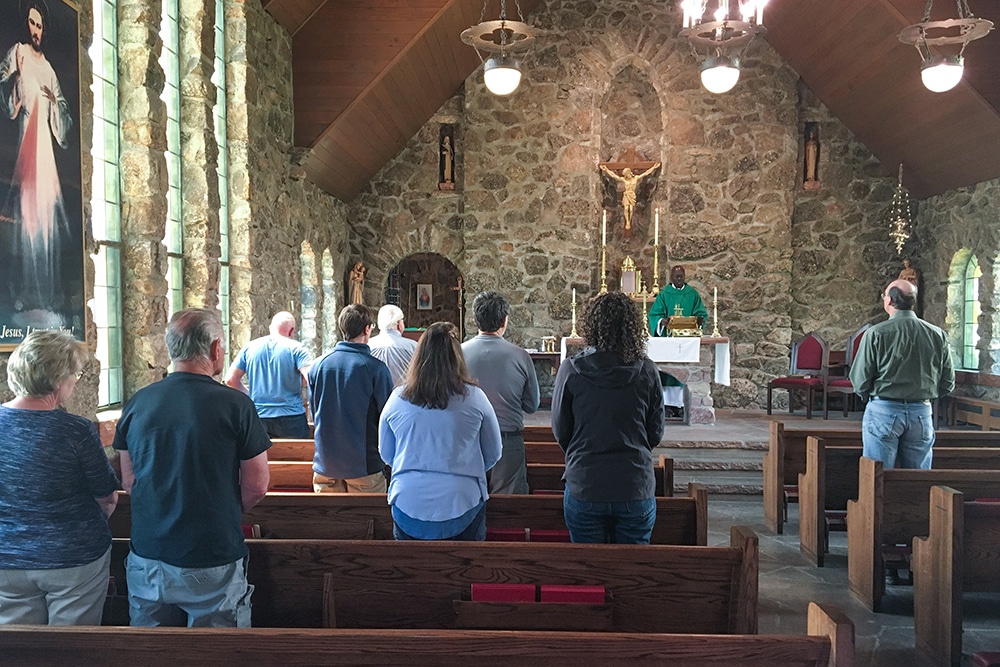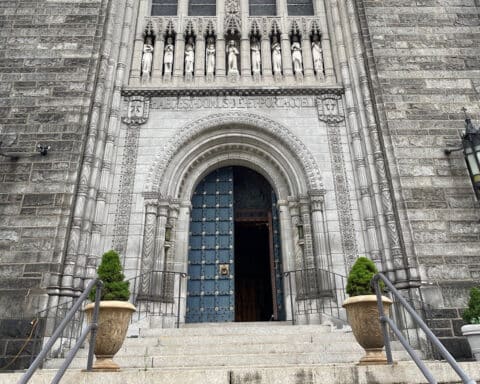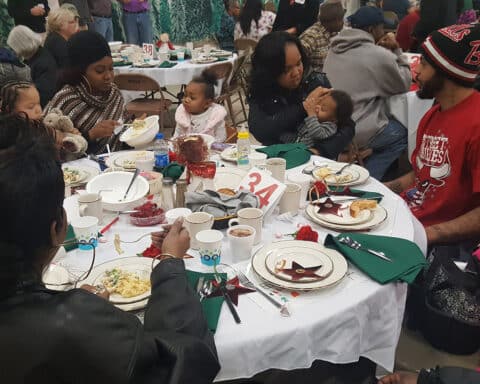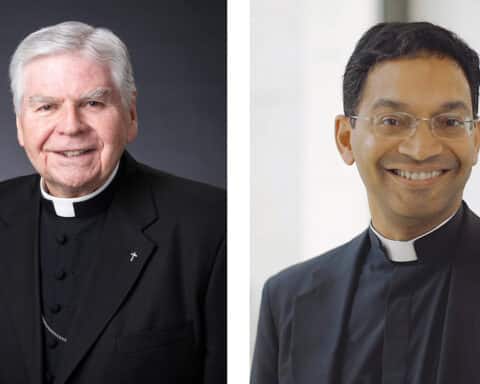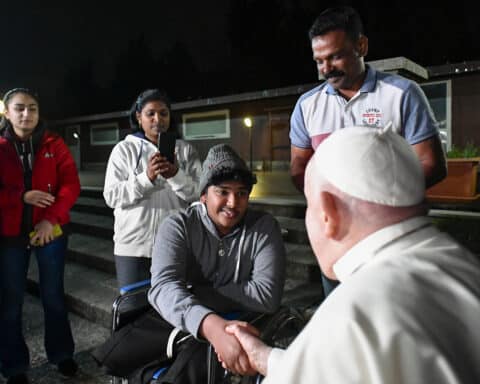Seven weeks had passed without any public Masses when the doors opened on the morning of May 1 at St. Martha Church in Porter, Texas.
More than 250 people turned out for the 8:30 a.m. Mass on a Friday. They had to wear face masks and sanitize their hands, but those were minor inconveniences for the faithful who went to church that morning.
“I can’t tell you the number of people with tears in their eyes when they received the Eucharist for the first time in seven weeks,” said Father T.J. Dolce, the pastor of St. Martha Church, which is located in a Houston suburb.
“I had one lady come up to me after Mass. She was a sobbing mess,” Father Dolce told Our Sunday Visitor. “She was so moved and touched that she was able to receive the Lord again. The people who came, it obviously meant a lot to them.”
On the first weekend of May, the Archdiocese of Galveston-Houston permitted its pastors to begin celebrating public Masses again, as long as they could reopen their churches while complying with Texas’ guidelines on social distancing protocols to control the spread of the coronavirus.
The Archdiocese of Galveston-Houston was one of at least 18 dioceses — mostly in the Midwest and South — that as of early May had either already reinstituted public Masses or announced intentions to do so before the end of the month. Many are located in lesser populated states such as Idaho, Montana, Nebraska, New Mexico, Alaska, North Dakota and South Dakota.
‘No one-size-fits-all approach’
At least five dioceses in Texas have brought back or will soon bring back public Masses. In late April, Texas Gov. Gregg Abbott announced a phased reopening of the state, which overall has not been as hard-hit by the pandemic as some states in the Northeast, the upper Midwest and along the East Coast.
“What we’re finding is that the pandemic is very much an issue of local governance, be it ecclesial or civil,” said Bishop Michael F. Olson of Fort Worth, Texas, who permitted the celebration of public Masses starting the weekend of May 2-3.
Bishop Olson, whose diocese consists of 28 counties, told Our Sunday Visitor he made the decision to permit public Masses after consulting with local and state health officials, medical experts, his presbyteral council and others.
“Each bishop has to make his own decisions on this, in the same way with the counsel he receives,” said Bishop Olson, who added that the coronavirus situation in some dioceses may look very different in locations that could be just 10 or 15 miles apart from each other.
“There’s no one-size-fits-all approach to this,” Bishop Olson said.
Guidelines available
The dioceses that have or will reopen are adopting similar protocols for the reopened Masses, such as only distributing Communion in the hand, roping off rows of pews, putting away hymnals and prayer cards for single-use paper worship aids, and restricting singing to a single cantor because singing may expel the virus more powerfully. The dioceses have continued their dispensations from the Sunday Mass obligation to ease the consciences of those who are urged to stay home during the pandemic, the elderly and the immuno-compromised.
The U.S. Conference of Catholic Bishops has issued a set of guidelines to the nation’s bishops that suggest phased reopenings, measures to ensure social distancing in churches and readily available hand sanitation during Mass.
The guidelines, which were developed by the Thomistic Institute at the Dominican House of Studies in Washington D.C., are among the resources that several dioceses contacted by Our Sunday Visitor said they have consulted in determining how to reopen their churches.
“We felt it was important, especially for our priests and for our lay faithful, to chart a road map, an exit strategy, in order to be honest, open and grown-up with people about what the thinking of the bishop is, and also to give people some hope that there is light at the end of the tunnel and that their sacrifices in recent times are not in vain and will not have to go in perpetuity,” said David Kerr, the communications director for the Diocese of Lansing, Michigan.
On May 18, the Diocese of Lansing will begin permitting public Masses. Kerr told Our Sunday Visitor that the suspension of public Masses in Lansing on March 18, when the pandemic began to hit the United States in earnest, “was very significant, and felt deeply by a lot of people.”
Bishop Earl Boyea of Lansing and his counterparts in other reopening dioceses are allowing local pastors to figure out how best to apply the public health and social distancing guidelines in their own parishes.
“The churches can open, but (pastors) have to figure out how many people they can fit in their church while standing 6 feet apart, and of course that number’s going to vary depending on the size of the church,” said Deacon Tim McNeil, chancellor for the Archdiocese of Omaha, Nebraska.
Pastors in the Archdiocese of Omaha have been allowed to celebrate public Masses since May 4, but some priests are choosing not to reopen their churches for the time being because of the complicated logistics.
“There are a lot of details the priests have to work out,” said Father Michel Mulloy, the diocesan administrator for the Diocese of Rapid City, South Dakota, which is currently without a bishop.
‘Health of body and soul’
With estimates that indicated South Dakota would pass its coronavirus “peak” in mid-May, both dioceses in the state — Sioux Falls and Rapid City — released a joint statement to tell the faithful that their local pastors will be permitted to begin celebrating public Masses after May 15 as long as proper hygiene and social distancing protocols will be in place.
“Our goal is to give the people of God from our dioceses the opportunity to celebrate Mass and to receive Communion, and to do that in a way that respects the guidelines we’ve been operating under for proper safe distancing, while observing the common understanding of how we keep from spreading this disease,” Father Mulloy said.
Bishop Donald DeGrood of Sioux Falls told Our Sunday Visitor that the Thomistic Institute’s guidelines were helpful for crafting the local Church’s approach to reopening. He added that several rural communities in the state have not had any confirmed cases of COVID-19.
“I prayed about it, and just had a very clear sense that the Lord is desiring, and the people are desiring, the Eucharist,” Bishop DeGrood said. “But we have to do it in a very prudent way, to keep people safe and do whatever we can reasonably do to minimize the risk of the spread of the disease.”
Fr. James A. Misko, the vicar general for the Diocese of Austin, Texas, helped develop a set of protocols that have been distributed to all parishes throughout the diocese, where priests were allowed to begin celebrating public Masses on May 5.
“We have been very consistent from the outbreak of this pandemic that we will work to open the liturgies as quickly as possible when it is safe to do so,” Father Misko said. “So the two go hand in hand, which we think is quite theological too: health of body and soul.”
Deacon Gene Fadness, the communications director for the Diocese of Boise, Idaho, where public Masses resumed on May 2, said most of the local priests he interviewed for a story in the diocesan newspaper, the Idaho Catholic Register, were eager to celebrate public Masses again.
“Each (priest) is approaching it a little differently,” Fadness told Our Sunday Visitor. “The majority are enthused about it, but they know all the precautions they will have to take.”
Brian Fraga is a contributing editor for Our Sunday Visitor.

